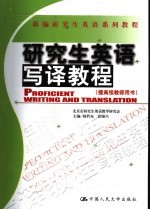

研究生英语写译教程 提高级教师用书PDF电子书下载
- 电子书积分:8 积分如何计算积分?
- 作 者:杨若东,袁锡兴主编;北京市研究生英语教学研究会编
- 出 版 社:北京:中国人民大学出版社
- 出版年份:2004
- ISBN:7300059694
- 页数:141 页
CONTENTS 2
Proficient Writing 写作篇 2
Part Ⅱ Building Good Sentences 2
Chapter Two Essential Qualities of Sentences 2
Section 2 Some Basic Qualities of Sentences 2
1.Sentence Clarity 2
2.Sentence Unity 7
3.Sentence Coherence 9
4.Sentence Emphasis 10
5.Sentence Euphony 11
6.Sentence Strength 12
4.Being Forceful 13
Section 1 Working on Readability 13
Chapter Three Producing Effective Sentences 13
Section 2 Manipulating Syntactic Structures for Sentence Coherence 14
1.Coordinating to Relate Equal Ideas 14
2.Subordinating to Distinguish the Main Idea 16
3.Choosing Clear Connectors 19
4.Using Parallelism 20
Section 3 Emphasizing Main Ideas 24
1.Arranging Ideas Effectively 24
2.Repeating Ideas 29
3.Separating Ideas 31
4.Preferring the Active Voice to the Passive Voice 32
1.Cutting Empty Words and Phrases 33
Section 4 Being Concise 33
2.Avoiding Unnecessary Repetition 34
3.Simplifying Word Groups and Sentences 35
4.Changing Negatives into Affirmatives 36
Section 5 Achieving Variety 38
1.Varying Sentence Length and Emphasis 39
2.Varying Sentence Beginnings 40
4.Varying Simple Sentences 42
Part Ⅲ Composing Peerless Paragraphs 44
Chapter Four Essential Qualities of Paragraphs 44
Section 1 Making the Topic Clear 44
2.Putting the Topic Sentence in the Best Place 47
Section 2 Maintaining Paragraph Unity 47
Section 3 Achieving Paragraph Coherence 51
1.Organizing the Paragraph 51
2.Using Parallel Structures 51
3.Repeating and Restating Words and Word Groups 53
4.Using Pronouns as Transitions 55
5.Using Synonyms as Transitions 56
6.Being Consistent 57
7.Using Formal Transitional Expressions 59
Chapter Five Developing Effective Paragraphs 63
Section 1 Developing the Paragraph Fully 63
Section 2 Choosing a Pattern of Development 64
Section 2 Closing an Essay 67
Section 1 Opening an Essay 67
Part Ⅳ Constructing Strong Essays 67
Chapter Six Writing Special Paragraphs 67
Chapter Seven Convincing the Audience 69
Section 1 Adopting a Reasonable Tone 69
Section 2 Selecting an Appropriate Style 70
Section 3 Making Assertions Believable 71
Section 4 Supporting the Assertions 72
Section 5 Reasoning Effectively 73
Section 1 The Exclamation Point ! 75
Section 2 The Comma, 75
Chapter Eight The Functions of Punctuations 75
Part Ⅴ Taking Advantage of Punctuations 75
Section 3 The Semicolon ; 80
Section 4 The Colon: 86
Section 6 Parentheses () 88
Section 7 The Dash — 88
Section 8 Quotation Marks “ ”and ‘ ’ 89
Proficient Translation 翻译篇 92
第一章 词语的翻译 92
二、词类的转换 92
三、增词与省略 92
四、四字词组的翻译 94
五、直译与意译(异化与归化) 95
一、主语的翻译 97
第二章 句子的翻译 97
二、定语的翻译 99
三、状语的翻译 100
四、被动语态的翻译 101
五、正反互译 102
六、修辞重现 103
第三章 篇章的翻译 107
一、照应 107
二、衔接 108
三、以段落为语篇翻译的基础 109
五、“洋为中用”适时转换语篇模式 110
一、长句的翻译方法 112
第四章 长句的翻译 112
二、名词性从句的翻译 113
三、定语从句的翻译 114
四、状语从句的翻译 116
第五章 不同文体的翻译 118
一、法律文件的翻译 118
二、文学的翻译 119
三、旅游材料的翻译 123
四、新闻报道的翻译 126
五、会话的翻译 129
六、论文摘要的翻译 130
七、应用文的翻译 131
八、有中国特色的文章的翻译 139
- 《红色旅游的社会效应研究》吴春焕著 2019
- 《高级英语阅读与听说教程》刘秀梅编著 2019
- 《汉语词汇知识与习得研究》邢红兵主编 2019
- 《生物质甘油共气化制氢基础研究》赵丽霞 2019
- 《思维导图 超好用英语单词书》(中国)王若琳 2019
- 《东北民歌文化研究及艺术探析》(中国)杨清波 2019
- 《联吡啶基钌光敏染料的结构与性能的理论研究》李明霞 2019
- 《异质性条件下技术创新最优市场结构研究 以中国高技术产业为例》千慧雄 2019
- 《《国语》和《战国策》词汇比较研究》陈长书著 2017
- 《中国制造业绿色供应链发展研究报告》中国电子信息产业发展研究院 2019
- 《大学计算机实验指导及习题解答》曹成志,宋长龙 2019
- 《中国当代乡土小说文库 本乡本土》(中国)刘玉堂 2019
- 《异质性条件下技术创新最优市场结构研究 以中国高技术产业为例》千慧雄 2019
- 《中国铁路人 第三届现实主义网络文学征文大赛一等奖》恒传录著 2019
- 《莼江曲谱 2 中国昆曲博物馆藏稀见昆剧手抄曲谱汇编之一》郭腊梅主编;孙伊婷副主编;孙文明,孙伊婷编委;中国昆曲博物馆编 2018
- 《中国制造业绿色供应链发展研究报告》中国电子信息产业发展研究院 2019
- 《中国陈设艺术史》赵囡囡著 2019
- 《指向核心素养 北京十一学校名师教学设计 英语 七年级 上 配人教版》周志英总主编 2019
- 《《走近科学》精选丛书 中国UFO悬案调查》郭之文 2019
- 《大学生心理健康与人生发展》王琳责任编辑;(中国)肖宇 2019
